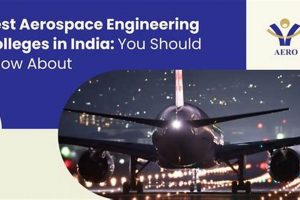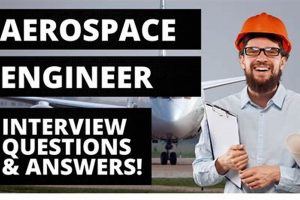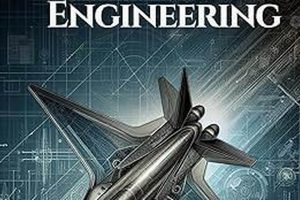A Bachelor of Technology degree focused on the design, development, testing, and production of aircraft, spacecraft, and related systems. The curriculum encompasses a broad spectrum of scientific and engineering principles, including aerodynamics, propulsion, structural analysis, materials science, and control systems. Students gain expertise in applying these principles to solve complex challenges in the aerospace field.
This specialized education provides a strong foundation for individuals aspiring to careers in the rapidly evolving aerospace sector. Graduates are equipped with the knowledge and skills necessary to contribute to advancements in aviation, space exploration, and defense technologies. Historically, this field has been at the forefront of technological innovation, driving progress in numerous other engineering disciplines. The demand for qualified professionals with expertise in this area remains consistently high due to the ongoing expansion of the aerospace industry and the increasing complexity of aerospace systems.
The subsequent sections will delve into specific aspects of this educational path, including curriculum details, career opportunities, and future trends shaping the field. Focus will be given to the core competencies acquired and their application in real-world scenarios within the aerospace domain.
Guidance for Pursuing Advanced Engineering Studies in the Aerospace Domain
The following recommendations are intended to provide prospective students with strategic insights into maximizing their potential within a rigorous and demanding academic program focused on aerospace systems.
Tip 1: Reinforce Foundational Knowledge: A robust understanding of mathematics (calculus, differential equations, linear algebra) and physics (mechanics, thermodynamics, electromagnetism) is paramount. Regularly review and practice fundamental concepts to ensure a solid base for advanced coursework.
Tip 2: Cultivate Programming Proficiency: Proficiency in programming languages such as Python, MATLAB, or C++ is essential for simulations, data analysis, and algorithm development. Dedicate time to learning and practicing coding skills, focusing on applications relevant to aerospace engineering problems.
Tip 3: Engage in Hands-on Projects: Seek opportunities to participate in practical projects, such as building model rockets, designing aircraft components, or developing control systems. These experiences provide invaluable real-world application of theoretical knowledge.
Tip 4: Develop Strong Communication Skills: Effective communication, both written and oral, is crucial for collaboration and conveying technical information. Practice presenting technical findings and writing clear, concise reports.
Tip 5: Prioritize Time Management: The curriculum is demanding and requires meticulous time management. Develop a structured schedule to allocate sufficient time for coursework, projects, and extracurricular activities.
Tip 6: Network with Professionals: Attend industry events, connect with aerospace engineers on professional platforms, and seek mentorship opportunities. Building a professional network can provide valuable insights and career guidance.
Tip 7: Stay Current with Industry Trends: The aerospace field is constantly evolving. Stay informed about emerging technologies, research advancements, and industry news through publications, conferences, and online resources.
Adherence to these guidelines will enhance the likelihood of academic success and facilitate a seamless transition into a rewarding career within the aerospace engineering field. A proactive and diligent approach to learning is essential for navigating the challenges and capitalizing on the opportunities presented by this dynamic discipline.
The subsequent sections will elaborate on specific career paths and areas of specialization available to graduates of such programs.
1. Aerodynamics Principles
Aerodynamics principles form a cornerstone of a B Tech in Aerospace Engineering. The study of air in motion and its interaction with solid objects is fundamental to the design, analysis, and performance of aircraft, spacecraft, and other aerospace vehicles. A thorough understanding of these principles is essential for optimizing lift, drag, stability, and control.
- Airfoil Design and Analysis
Airfoil design and analysis involve the application of aerodynamic principles to create shapes that generate lift efficiently. Engineers utilize computational fluid dynamics (CFD) simulations and wind tunnel testing to evaluate airfoil performance characteristics. This knowledge is crucial for designing wings, rotors, and other lifting surfaces that maximize aerodynamic efficiency while minimizing drag. Improper airfoil design can lead to reduced lift, increased drag, and compromised aircraft performance.
- Boundary Layer Theory
Boundary layer theory describes the behavior of the thin layer of air adjacent to the surface of an object moving through the atmosphere. Understanding boundary layer effects, such as transition from laminar to turbulent flow, is critical for predicting drag and heat transfer. Engineers employ boundary layer control techniques, such as suction or blowing, to delay transition and reduce drag. Ignoring boundary layer effects can result in inaccurate drag predictions and suboptimal aerodynamic designs.
- Compressible Flow Effects
Compressible flow effects become significant at high speeds, approaching or exceeding the speed of sound. Phenomena such as shock waves, expansion fans, and sonic booms influence the aerodynamic characteristics of aircraft and spacecraft. Engineers must account for these effects when designing high-speed vehicles to ensure stability and control. Failure to consider compressible flow can lead to performance degradation, increased drag, and structural damage.
- Stability and Control
Stability and control analysis ensures that an aircraft or spacecraft can maintain its desired flight path and respond predictably to pilot inputs. Aerodynamic forces and moments acting on the vehicle are analyzed to determine its static and dynamic stability characteristics. Engineers design control surfaces and systems to provide the necessary control authority. Insufficient stability or inadequate control can result in unsafe flight conditions and loss of control.
The understanding and application of these aerodynamics principles are integral to the success of a B Tech graduate. These principles underpin the design process, influencing performance, safety, and efficiency. A strong foundation in aerodynamics enables engineers to contribute to advancements in aerospace technology and address complex challenges in the field.
2. Propulsion Systems Design
Propulsion Systems Design is a crucial element within the curriculum of a B Tech in Aerospace Engineering. This specialization addresses the principles and practices involved in creating systems that generate thrust to propel aerospace vehicles. Mastery of propulsion systems design is essential for engineers seeking to contribute to the development of efficient and reliable aerospace transportation.
- Thermodynamics and Combustion
The study of thermodynamics and combustion forms the basis for understanding the energy conversion processes within propulsion systems. This includes analyzing thermodynamic cycles, such as the Brayton cycle in gas turbine engines, and understanding the chemical kinetics of combustion processes. Accurate thermodynamic modeling and combustion analysis are essential for optimizing engine performance and minimizing emissions. For example, improved combustion chamber designs can lead to more complete combustion and reduced pollutant formation.
- Rocket Propulsion
Rocket propulsion focuses on the design and analysis of rocket engines, which utilize chemical propellants to generate thrust for space launch and orbital maneuvers. This area encompasses the study of solid, liquid, and hybrid rocket propulsion systems, as well as the analysis of nozzle performance and combustion stability. The development of advanced rocket engines with higher specific impulse and improved reliability is critical for enabling more cost-effective space access. Examples include the development of reusable rocket engines like those used in SpaceX’s Falcon 9 launch vehicle.
- Gas Turbine Engines
Gas turbine engines are widely used for aircraft propulsion due to their high power-to-weight ratio and fuel efficiency. The design of gas turbine engines involves optimizing the performance of components such as compressors, turbines, and combustors. Aerodynamic design and materials selection are critical considerations for ensuring efficient and reliable operation. Advances in gas turbine engine technology, such as the development of geared turbofans, have led to significant improvements in fuel efficiency and noise reduction.
- Electric Propulsion
Electric propulsion utilizes electric fields to accelerate ions or plasma, generating thrust with high efficiency. This technology is particularly well-suited for long-duration space missions and orbital adjustments. Different types of electric propulsion systems, such as ion thrusters and Hall effect thrusters, offer varying performance characteristics. The development of high-power electric propulsion systems is enabling ambitious space exploration missions, such as deep-space probes and asteroid redirection missions.
The various facets of propulsion systems design underscore the breadth and depth of knowledge required for a B Tech graduate in Aerospace Engineering to contribute meaningfully to the field. From understanding the fundamental principles of thermodynamics to developing advanced electric propulsion systems, the expertise gained in this area is crucial for advancing aerospace technology and enabling future space exploration endeavors.
3. Aircraft Structures Analysis
Aircraft Structures Analysis is an indispensable component of a B Tech in Aerospace Engineering. This discipline focuses on determining the behavior of aircraft structures under various loads and environmental conditions. It ensures the structural integrity, safety, and reliability of aircraft throughout their operational life. Proficiency in this area is fundamental for aerospace engineers involved in design, testing, and maintenance.
- Finite Element Analysis (FEA)
Finite Element Analysis (FEA) is a numerical method used to simulate the behavior of complex structures under stress. It involves dividing a structure into smaller elements and applying mathematical equations to approximate the stress, strain, and displacement within each element. FEA is widely used in aerospace engineering to analyze aircraft wings, fuselage sections, and landing gear. For example, FEA can be used to predict the stress distribution in a wing subjected to aerodynamic loads, allowing engineers to identify areas of high stress concentration and optimize the design for strength and weight. Ignoring FEA during design could lead to structural failure and catastrophic incidents.
- Stress and Strain Analysis
Stress and strain analysis forms the theoretical foundation for understanding the mechanical behavior of materials under load. Stress refers to the internal forces acting within a material, while strain represents the deformation of the material. Aerospace engineers use stress and strain analysis to determine the load-carrying capacity of aircraft structures and to ensure that they can withstand the stresses imposed during flight. For instance, the analysis of stress concentrations around fastener holes is critical to prevent fatigue cracks from initiating and propagating. Inadequate stress analysis can result in premature structural failure and loss of airworthiness.
- Fatigue and Fracture Mechanics
Fatigue and fracture mechanics address the long-term durability of aircraft structures under cyclic loading. Fatigue refers to the progressive damage that occurs due to repeated stress cycles, while fracture mechanics deals with the growth of cracks and their eventual failure. Aerospace engineers use fatigue and fracture mechanics to predict the lifespan of aircraft components and to develop inspection and maintenance schedules to prevent catastrophic failures. A real-world example includes the implementation of non-destructive testing (NDT) methods, such as ultrasonic inspection, to detect cracks in aircraft wings before they reach critical size. Neglecting fatigue analysis can lead to unexpected structural failures and jeopardize passenger safety.
- Composite Materials Analysis
Composite materials, such as carbon fiber reinforced polymers, are increasingly used in aircraft structures due to their high strength-to-weight ratio. Composite materials analysis involves understanding the unique mechanical behavior of these materials, including their anisotropic properties and susceptibility to damage. Aerospace engineers use specialized analysis techniques to design and analyze composite structures. This includes considerations for laminate stacking sequence, fiber orientation, and matrix properties. Misunderstanding the behavior of composite materials can lead to delamination, fiber breakage, and reduced structural performance.
The integration of these analytical methods within a B Tech in Aerospace Engineering ensures graduates possess the expertise needed to design, analyze, and maintain safe and reliable aircraft structures. Through rigorous coursework and practical application, students develop the skills necessary to address the challenges of modern aerospace engineering, contributing to the continued advancement of aviation safety and performance.
4. Control Engineering Expertise
Control engineering expertise is an intrinsic component of a Bachelor of Technology in Aerospace Engineering. The discipline provides the theoretical framework and practical skills necessary for designing, implementing, and analyzing control systems within aerospace vehicles and related technologies. The absence of robust control systems renders stable and efficient operation of aircraft, spacecraft, and unmanned aerial vehicles (UAVs) unattainable. Therefore, expertise in this area is not merely beneficial but essential for graduates intending to contribute meaningfully to the field.
The practical application of control engineering principles is evident in numerous aerospace systems. Flight control systems, for example, utilize sensors, actuators, and feedback loops to maintain stability, execute maneuvers, and compensate for disturbances such as wind gusts. Similarly, attitude control systems on spacecraft employ reaction wheels or thrusters to maintain desired orientations in space. Moreover, autopilots and autonomous navigation systems rely heavily on advanced control algorithms to execute pre-programmed flight paths or adapt to changing environmental conditions. A deficiency in understanding control systems can directly lead to instability, performance degradation, and even catastrophic failures in these applications. For instance, poorly tuned control loops can induce oscillations, while inadequate robustness margins can result in sensitivity to sensor noise or actuator limitations.
In summary, control engineering expertise forms a critical pillar of aerospace engineering education. Its integration into the curriculum equips graduates with the skills to design, analyze, and implement robust control systems that are fundamental to the safe and effective operation of aerospace vehicles. While challenges remain in developing increasingly complex and autonomous control systems, a firm grounding in the fundamental principles of control engineering remains indispensable for aerospace engineers navigating the demands of the modern aerospace industry. The ability to translate theoretical knowledge into practical applications distinguishes competent engineers and contributes to the advancement of aerospace technology.
5. Spacecraft Systems Integration
Spacecraft Systems Integration, as a discipline within a B Tech in Aerospace Engineering, represents the culmination of various engineering principles applied to the construction and operation of functional spacecraft. The program’s curriculum delivers a holistic understanding of spacecraft architecture, encompassing the interdependencies between subsystems, such as power generation and distribution, thermal control, communications, attitude determination and control, propulsion, and payload instrumentation. Success in this field hinges on comprehending the impact of each subsystem on the overall performance and mission objectives of the spacecraft.
The importance of Spacecraft Systems Integration stems from the inherent complexity of spacecraft design. A malfunction in one subsystem can cascade through the entire system, potentially leading to mission failure. For example, an inadequate thermal control system can cause overheating of sensitive electronic components, resulting in their malfunction. Similarly, a failure in the attitude control system can compromise the spacecraft’s ability to point its instruments accurately, rendering the mission’s data collection efforts useless. Real-world examples, such as the Hubble Space Telescope’s initial blurred images due to a manufacturing defect in its primary mirror, underscore the critical need for rigorous systems integration processes, encompassing thorough testing and validation, from component level to full system integration.
The practical significance of understanding Spacecraft Systems Integration lies in the ability to design robust and reliable spacecraft capable of performing complex missions in the harsh environment of space. The skillset acquired enables graduates to tackle the challenges of integrating diverse technologies, optimizing system performance, and mitigating potential risks. Graduates are prepared for roles in areas spanning design, manufacturing, testing, and operations, all contributing to the advancement of space exploration and utilization. The ongoing miniaturization of spacecraft components, coupled with the increasing demand for sophisticated space-based services, necessitates a continuing emphasis on systems integration expertise within aerospace engineering programs.
Frequently Asked Questions
The following section addresses common inquiries regarding undergraduate studies in aerospace engineering. The information presented aims to provide clarity and guidance for prospective students.
Question 1: What are the fundamental differences between aeronautical and aerospace engineering?
Aeronautical engineering primarily focuses on the design and development of aircraft operating within Earth’s atmosphere. Aerospace engineering encompasses both aeronautical engineering and astronautical engineering, the latter concerning spacecraft and the challenges of operating in outer space.
Question 2: What core subjects are typically included in the curriculum of a B Tech in Aerospace Engineering?
The curriculum generally includes aerodynamics, propulsion, structural analysis, flight mechanics, control systems, materials science, and spacecraft design. Mathematics and physics form the theoretical foundation.
Question 3: What career paths are available to graduates with a B Tech in Aerospace Engineering?
Potential career paths include roles in aircraft design and manufacturing, spacecraft development, propulsion systems engineering, flight testing, research and development, and government agencies. Opportunities also exist in related fields like robotics and renewable energy.
Question 4: Is it necessary to possess advanced mathematical skills to succeed in a B Tech in Aerospace Engineering?
A strong foundation in mathematics, including calculus, differential equations, and linear algebra, is essential. These skills are necessary for understanding and applying complex engineering principles.
Question 5: What are some common misconceptions about the field of aerospace engineering?
One misconception is that aerospace engineers only work on rockets and spacecraft. In reality, a significant portion of the field is dedicated to aircraft design and aviation-related technologies. Another misconception is that it is a highly theoretical field with limited practical application; however, hands-on experience through projects and internships is a crucial component of most programs.
Question 6: What steps can prospective students take to prepare for a B Tech in Aerospace Engineering?
Prospective students should focus on strengthening their skills in mathematics and physics. Engaging in science and engineering-related extracurricular activities, such as robotics clubs or model aircraft building, can also provide valuable experience. Familiarity with computer-aided design (CAD) software and programming languages can be beneficial.
In summary, a B Tech in Aerospace Engineering provides a comprehensive education for individuals seeking to contribute to the advancement of aviation and space exploration. A strong foundation in mathematics, physics, and engineering principles is essential for success in this challenging and rewarding field.
The following article section explores the current state and future trends of Aerospace Engineering.
Conclusion
This article has provided an overview of the key elements of a B Tech in Aerospace Engineering, encompassing core principles, crucial areas of specialization, and frequently asked questions relevant to prospective students. Emphasis has been placed on the interdisciplinary nature of this engineering field, the necessary analytical skills, and the diverse career opportunities available to graduates.
Given the continued advancements in aviation, space exploration, and related technologies, the demand for skilled aerospace engineers remains substantial. Individuals considering this career path are encouraged to pursue rigorous academic preparation and engage in practical experiences to maximize their potential for success in this critical sector.






![Guide: Aerospace Engineering Iowa State Flowchart [2024] Innovating the Future of Flight with Reliable Aviation Solutions Guide: Aerospace Engineering Iowa State Flowchart [2024] | Innovating the Future of Flight with Reliable Aviation Solutions](https://mixaerospace.com/wp-content/uploads/2025/12/th-546-300x200.jpg)
